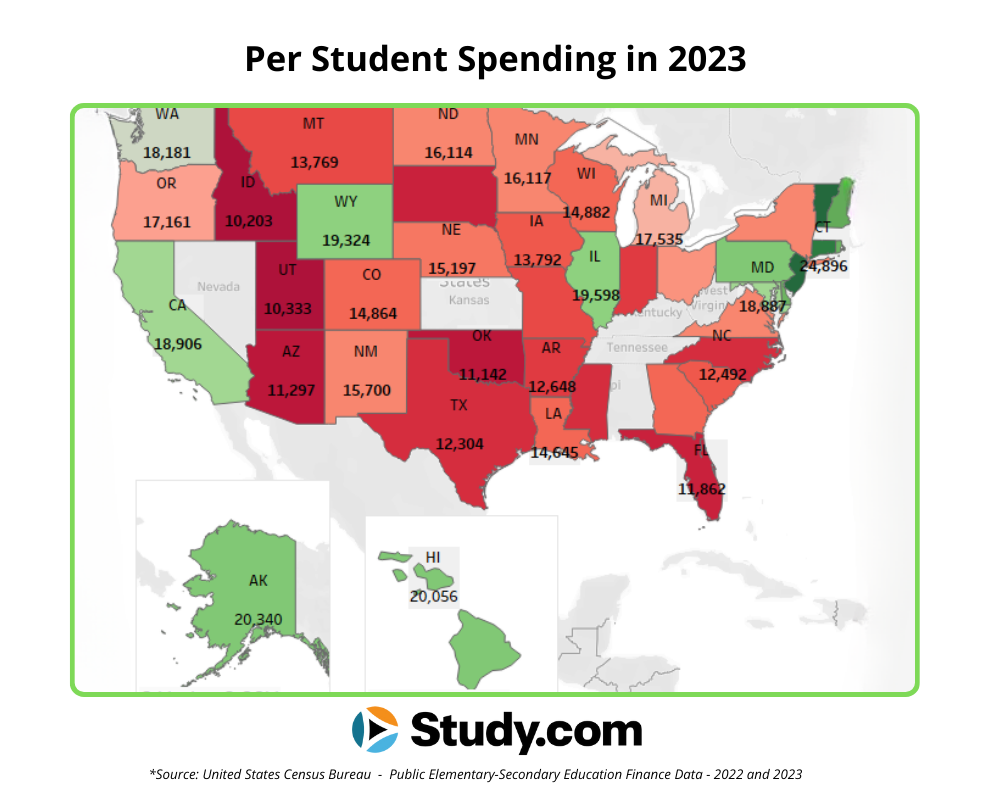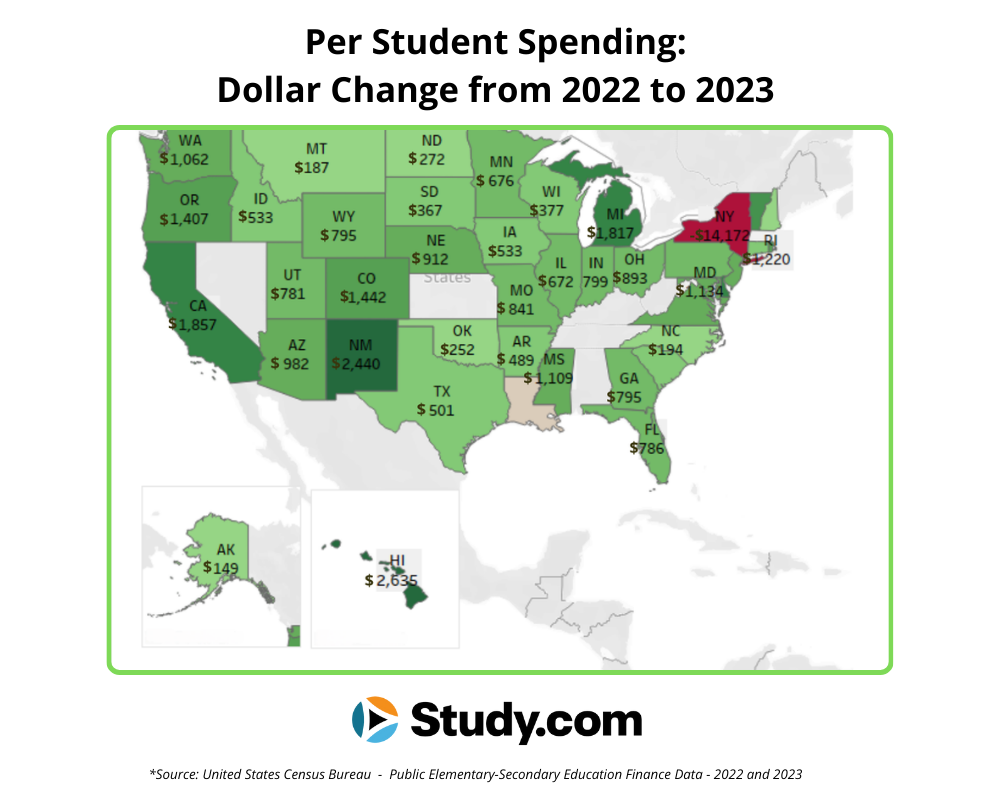Winners and losers in public school funding: How does your state compare?

SoupAhDopeVisuals // Shutterstock
Winners and losers in public school funding: How does your state compare?
In 2019, Oregon K-12 teachers walked in protest of a lack of funding for public schools.
National Education Month is not only a great time to honor the important work of teachers and school staff but also to assess how states invest in public education. Research from the Public Policy Institute of California shows that “increases in spending lead to improved student outcomes, ranging from test scores, to graduation, to college attendance, to adult earnings and poverty.”
In this article, Study.com explores United States Census Bureau’s Public Elementary-Secondary Education Finance Data from 2022 and 2023 to examine how states allocate resources to public schools and the variations in funding priorities across states. Some states are missing from this analysis due to unavailable data.
2022 to 2023 Funding Shifts
Many states have been working to increase public education budgets to bolster student outcomes and close resource gaps. Nationally, that has added up to the biggest boost of educational expenditure in 20 years with the U.S. Census Bureau reporting that in 2022 spending had gone up 8.9% compared to the previous year.
States can decide how to allocate funds for education, which has resulted in a different landscape for public education in each state. For example, in Michigan, the 2023 school budget focused on educational equity with funds going toward special education, at-risk students, rural bus transportation, and free breakfast and lunch. Minnesota’s 2023 education budget grew by $2.3 billion from the previous year, allocating more funds directly to local school districts and including new funds to help support early childhood education. In states like Florida and North Carolina, budgets included the expansion of school choice and voucher programs.
Many states face the struggle of keeping pace with inflation—one example is Wisconsin, where opponents of the education budget argue that despite a $325 per pupil increase, the high rate of inflation all but nullifies it. Another is Colorado, which bases school funding on student enrollment and inflation. Because enrollment in Colorado public schools has dropped, increases have relied on inflation, leveling out any funding gains, some argue.
How Pandemic Impacted Funding
The COVID-19 pandemic brought substantial changes to U.S. schools, including an increase in federal funding. One part of the Coronavirus Aid, Relief, and Economic Security (CARES) Act was the Elementary and Secondary School Emergency Relief (ESSER) program that allocated $189.5 billion to K-12 schools.
In the early days of the pandemic, money went to expanding and supporting hybrid and remote learning, including providing students with laptops and even WiFi access. In response, the EdTech market saw a 17% annual growth during the pandemic, with states continuing to invest in technology.
ESSER dollars were also spent on addressing critical needs, such as implementing health protocols, supporting school operations, and helping schools re-open. Many schools invested the funds in teachers and staff, earmarking money for hiring and increasing teacher pay. Grappling with the student mental health crisis during the pandemic, schools used federal funds to sustain and build mental health services. For example, Florida put $2 million of CARES Act funds toward reducing the mental health professional-to-student ratio in rural school districts and expanding access to mental health services.
Shifting Priorities Post-COVID-19
The deadline for spending ESSER funds was Sept. 30, 2024; however, some states have been granted extensions that run through 2026. With this boost of federal funding phasing out, states will need to return to their pre-pandemic funding models and make hard decisions about which ESSER-funded programs and supports will continue.
Post-pandemic, priorities have shifted with a sharper focus on academic recovery, student mental health, and teacher retention. A McKinsey report found that districts were planning to put the last of their ESSER funds toward addressing chronic absenteeism and offering more counseling services—Illinois planned to use its funds to boost social-emotional learning (SEL) support by creating SEL hubs throughout the state.
With teacher shortages still plaguing most districts and teacher retention rates dropping, states have focused on shoring up their own teacher pipelines. While some states have updated their licensing process to make it easier for people to become teachers, others have used funds to build up grow-your-own programs, which recruit future teachers from the ranks of support staff and aides.
Regional Disparities in Education Spending
Every state has a unique process or formula for determining its education budget, and usually, funds come from federal, state, and local levels. Most states calculate funding on a per-student basis (either based on enrollment or attendance) with more weight given to certain student populations like low-income students and special education students. Other states have a resource-based model, allocating money for services and staffing, or use a guaranteed tax base model that pulls from local and state taxes.
![]()

Study.com
Top 10 States by Per-Pupil Spending in 2023
Heatmap showing data on each state and its per student spending in 2023.
Because of the varied formulas that determine state education budgets, per-pupil spending varies greatly across the country. The states below, however, had the highest per-pupil spending in 2023:
- Vermont: $26,345
- New Jersey: $26,280
- Connecticut: $24,896
- New Hampshire: $21,731
- Delaware: $21,340
- Rhode Island: $21,182
- Alaska: $20,340
- Hawaii: $20,056
- Pennsylvania: $20,056
- Illinois: $19,598
Vermont’s education finance system emphasizes local control with school boards setting their budgets and then turning them over to voters to approve—that state also relies on property taxes and other taxes to fund schools. New Jersey’s School Funding Reform Act of 2008 was put in place to ensure that lower-income school districts had equitable access to state resources, and like Vermont, local tax revenue is also put toward funding schools.

Study.com
Top 10 States with the Largest Increases in Per-Pupil Spending
Heatmap showing data on each state and its per student spending and dollar change from 2022 to 2023.
A handful of states had large increases in their per-pupil spending with the largest being:
- Hawaii: +$2,635.22
- New Mexico: +$2,440.45
- Delaware: +$1,983.43
- California: +$1,856.56
- Michigan: +$1,816.55
- Vermont: +$1,736.62
- Colorado: +$1,441.53
- Oregon: +$1,407.32
- Rhode Island: +$1,219.74
- New Jersey: +$1,180.90
Hawaii’s per-pupil spending benefited from almost $73 million in new federal funds that were aimed at helping Title I schools, which are schools with a high number of low-income students. With this money, schools could invest in technology, hire teachers, and provide professional development.
In California, the Learning Recovery Emergency Block was part of the 2022-2023 budget but these funds are still being used for pandemic recovery, focusing on learning loss. California’s 2023 budget had a big cost-of-living adjustment (COLA) to help with funding and included $20 million to help develop more bilingual teachers.
States with the Lowest Per-Pupil Spending in 2023
Budget limitations and fiscally conservative spending policies are often the hallmarks of states with low per-pupil spending. In 2023, these were the states with the smallest amounts of per-pupil spending:
- Idaho: $10,203
- Utah: $10,333
- Oklahoma: $11,142
- Arizona: $11,297
- Florida: $11,862
- South Dakota: $11,932
- Mississippi: $12,093
- Texas: $12,304
- North Carolina: $12,492
- Arkansas: $12,648
Idaho has routinely ranked lowest in per-pupil spending, partly due to state funding that relies on local levies and local grants. During the pandemic, Idaho altered the way the state education budget was formulated, basing funding on enrollment and not attendance; however, that change has been reversed, which could lead to less money for schools. With pandemic funds also expiring and despite a 16.4% increase in general education fund spending in 2023, schools are bracing for steep cuts.
Although Utah’s education budget has grown from $3.8 billion in 2014 to $7.7 billion in 2024, like Idaho, Utah also lags in local and state funding because it depends on state income tax and property tax revenue, and with smaller populations, that means less funding. What’s more, funding is adjusted for enrollment and inflation, but Utah is expected to see a decline in public school enrollment, which can lead to even lower per-pupil spending.
States Decreasing Per-Pupil Spending from 2022 to 2023
Two states in particular saw decreases in their per-pupil spending:
- Louisiana: -$283.71
- New York: -$14,172.37
Louisiana determines its education spending based on its Minimum Foundation Program (MFP) formula, and state budget deficits in past years meant little, if any, money was left to put toward increasing the education budget. Although teachers received stipends in the amount of $2,000 in 2023, early childhood education dollars were cut and the state is projected to see almost $250 million cut from the education budget in 2025 due to a state sales tax reduction.
As for New York, last year Mayor Eric Adams announced a sizable $547 million cut in New York City’s Education Department’s budget. The biggest impact will be felt by the city’s free preschool program and other community programs. A teacher hiring freeze and the elimination of vacant non-classroom positions is expected, too. Mayor Adams argued the cuts were necessary due to an influx of asylum seekers creating a financial strain for the city in addition to COVID-19 funds running out.
This story was produced by Study.com and reviewed and distributed by Stacker.